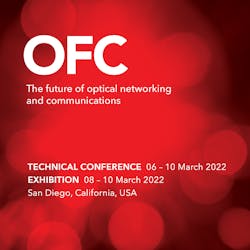OFC touts fiber network disaggregation for rural markets
By Optical Fiber Communication Conference and Exhibition (OFC) Staff
This technical brief in a runup to OFC 2022 (March 6-10) contends that optimizing computer networks through disaggregation enables deployment of better networks and expansion of rural coverage, unlocking broader economic benefits for society.
A metropolitan area network (MAN) is a computer network that provides services, typically through fiber-optic cables, to businesses and homes, such as databases and media content. In MANs, traffic is aggregated from computer access points across a metropolitan area, covering distances up to 200 kilometers, and establishing paths towards the network's core.
Network disaggregation allows the elements in a MAN to come from different vendors and providers. These elements are then combined with a common programming interface. Through disaggregation, network operators can choose the elements most convenient in terms of performance and cost, and upgrade individual components only as needed.
Ultimately, disaggregated networks could allow operators to deploy innovative network functions faster and more flexibly in order to support new and improved services and expand into rural markets. This network transformation also provides opportunities for additional participants in the supply chain, including the entry of new companies and vendors.
Josep Fabrega, of the Centre Tecnològic de Telecomunicacions de Catalunya (CTTC), who was a part of the team to develop a MAN disaggregation approach, will discuss this in further detail at the upcoming 2022 OFC Conference and Exhibition on Sunday, 06 March from 13:00 – 15:30.
The research was part of the EU-H2020 PASSION project, which supports the development of future MANs with high transmission capacity, low cost and reduced energy consumption. The project focused on the network and its key elements, transceivers and network nodes, which were developed by different partners.
Fabrega and his team demonstrated the feasibility of a disaggregated MAN by considering each relevant component. They used sliceable bandwidth/bitrate variable transceivers, which are multi-flow programmable and enable point-to-multipoint connectivity.
"The challenge (with the transceivers) is to have a cost-effective solution," said Fabrega. "So, the PASSION project developed a photonic integrated solution that involves the use of specifically engineered photonic integrated circuits (PIC) and vertical-cavity surface-emitting lasers (VCSELs) for the transmitter part. The receiver part is relying on, again, specifically engineered PICs for coherent detection."
PICs provide a compact/integrated version of typically bulky devices, saving space and power consumption. Concurrently, VCSELs offer the advantages of low cost and optical efficiency within a small footprint. VCSELs are lower cost, due to a more straightforward manufacturing process than traditional common semiconductor lasers. They also conserve power consumption, because they need less electric current for operation.
For the network nodes, the researchers proposed an architecture depending on hierarchy level (HL). The HLs can be visualized as concentric rings, where traffic is aggregated from lower to upper levels. For example, traffic coming from HL4 is aggregated at HL3. In turn, HL3 traffic is aggregated at HL2, and so forth. Each transition means that more traffic must be supported.
"For HL4 nodes, PASSION proposes an architecture based on arrayed waveguide gratings in combination with semiconductor optical amplifiers," said Fabrega. "For higher hierarchy levels, a solution is proposed combining different types of wavelength selective switches together with innovative polymer switching stages."
The team tested their MAN with a transmission experiment and demonstrated a capacity of 1.6 terabytes per second, which is modest compared to the possible performance of the network but demonstrates the feasibility of the concept. In the future, the researchers believe some of the constituent devices could be further improved to provide more flexibility.

